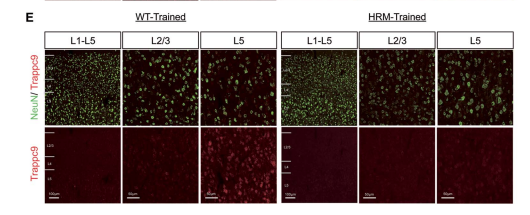TRAPPC9 Antibody - #DF12489
製品説明
*The optimal dilutions should be determined by the end user. For optimal experimental results, antibody reuse is not recommended.
*Tips:
WB: For western blot detection of denatured protein samples. IHC: For immunohistochemical detection of paraffin sections (IHC-p) or frozen sections (IHC-f) of tissue samples. IF/ICC: For immunofluorescence detection of cell samples. ELISA(peptide): For ELISA detection of antigenic peptide.
引用形式: Affinity Biosciences Cat# DF12489, RRID:AB_2845294.
折りたたみ/展開
1810044A24Rik; 2900005P22Rik; 4632408O18Rik; Ibp; IKBKBBP; Ikk2 binding protein; KIAA1882; MGC4737; MGC4769; mKIAA1882; MRT13; Nibp; NIK and IKK(beta) binding protein; NIK and IKK{beta} binding protein; RGD1309461; T1; Trafficking protein particle complex 9; TRAPP 120 kDa subunit; TRS130; Tularik gene 1 protein;
免疫原
A synthesized peptide derived from human TRAPPC9, corresponding to a region within the internal amino acids.
Expressed at high levels in muscle and kidney and to a lower extent in brain, heart and placenta.
- Q96Q05 TPPC9_HUMAN:
- Protein BLAST With
- NCBI/
- ExPASy/
- Uniprot
MSVPDYMQCAEDHQTLLVVVQPVGIVSEENFFRIYKRICSVSQISVRDSQRVLYIRYRHHYPPENNEWGDFQTHRKVVGLITITDCFSAKDWPQTFEKFHVQKEIYGSTLYDSRLFVFGLQGEIVEQPRTDVAFYPNYEDCQTVEKRIEDFIESLFIVLESKRLDRATDKSGDKIPLLCVPFEKKDFVGLDTDSRHYKKRCQGRMRKHVGDLCLQAGMLQDSLVHYHMSVELLRSVNDFLWLGAALEGLCSASVIYHYPGGTGGKSGARRFQGSTLPAEAANRHRPGAQEVLIDPGALTTNGINPDTSTEIGRAKNCLSPEDIIDKYKEAISYYSKYKNAGVIELEACIKAVRVLAIQKRSMEASEFLQNAVYINLRQLSEEEKIQRYSILSELYELIGFHRKSAFFKRVAAMQCVAPSIAEPGWRACYKLLLETLPGYSLSLDPKDFSRGTHRGWAAVQMRLLHELVYASRRMGNPALSVRHLSFLLQTMLDFLSDQEKKDVAQSLENYTSKCPGTMEPIALPGGLTLPPVPFTKLPIVRHVKLLNLPASLRPHKMKSLLGQNVSTKSPFIYSPIIAHNRGEERNKKIDFQWVQGDVCEVQLMVYNPMPFELRVENMGLLTSGVEFESLPAALSLPAESGLYPVTLVGVPQTTGTITVNGYHTTVFGVFSDCLLDNLPGIKTSGSTVEVIPALPRLQISTSLPRSAHSLQPSSGDEISTNVSVQLYNGESQQLIIKLENIGMEPLEKLEVTSKVLTTKEKLYGDFLSWKLEETLAQFPLQPGKVATFTINIKVKLDFSCQENLLQDLSDDGISVSGFPLSSPFRQVVRPRVEGKPVNPPESNKAGDYSHVKTLEAVLNFKYSGGPGHTEGYYRNLSLGLHVEVEPSVFFTRVSTLPATSTRQCHLLLDVFNSTEHELTVSTRSSEALILHAGECQRMAIQVDKFNFESFPESPGEKGQFANPKQLEEERREARGLEIHSKLGICWRIPSLKRSGEASVEGLLNQLVLEHLQLAPLQWDVLVDGQPCDREAVAACQVGDPVRLEVRLTNRSPRSVGPFALTVVPFQDHQNGVHNYDLHDTVSFVGSSTFYLDAVQPSGQSACLGALLFLYTGDFFLHIRFHEDSTSKELPPSWFCLPSVHVCALEAQA
種類予測
Score>80(red) has high confidence and is suggested to be used for WB detection. *The prediction model is mainly based on the alignment of immunogen sequences, the results are for reference only, not as the basis of quality assurance.
High(score>80) Medium(80>score>50) Low(score<50) No confidence
研究背景
Functions as an activator of NF-kappa-B through increased phosphorylation of the IKK complex. May function in neuronal cells differentiation. May play a role in vesicular transport from endoplasmic reticulum to Golgi.
Golgi apparatus>cis-Golgi network. Endoplasmic reticulum. Cytoplasm.
Note: Processes and cell bodies of neurons.
Expressed at high levels in muscle and kidney and to a lower extent in brain, heart and placenta.
Belongs to the NIBP family.
参考文献
Application: IF/ICC Species: Mouse Sample:
Restrictive clause
Affinity Biosciences tests all products strictly. Citations are provided as a resource for additional applications that have not been validated by Affinity Biosciences. Please choose the appropriate format for each application and consult Materials and Methods sections for additional details about the use of any product in these publications.
For Research Use Only.
Not for use in diagnostic or therapeutic procedures. Not for resale. Not for distribution without written consent. Affinity Biosciences will not be held responsible for patent infringement or other violations that may occur with the use of our products. Affinity Biosciences, Affinity Biosciences Logo and all other trademarks are the property of Affinity Biosciences LTD.



